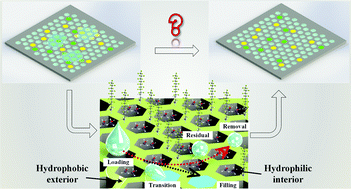Heterogeneous modification of through-hole microwell chips for ultralow cross-contamination digital polymerase chain reaction†
Abstract
Chip-based dPCR (cdPCR) with a physical boundary between micro-units allows for high parallelism, robustness and sensitivity. However, cross-contamination between micro-units is still a problem that affects the accuracy of results. To overcome this problem, we introduced a heterogeneous modification strategy by microcontact printing to prepare a through-hole microwell chip (TMC) with a hydrophobic exterior surface and hydrophilic interior surface. The modified TMC can reduce cross-contamination (sample residual rate (SRR) of (4.9 ± 1.5)%) by an efficient partitioning yield (unit filling rate (UFR) of (91.1 ± 2.2)%). The sample-residual properties of modified TMCs could be tuned by the reaction conditions. As the contact time increased, the surface CA of the TMC increased, which caused decreases of the SRR and UFR. However, prolonging the contact time to 25 s would cause a sharp reduction of the UFR. The modified TMCs with high UFRs were used for further dPCR studies. The fluorescence images of dPCR chips were collected by fluorescence microscopy and a self-developed optical system, followed by image processing and data statistics to obtain quantitative results. The copy number variation results of the surface hydrophobic TMC was closer to the true value compared to that of the hydrophilic TMC. The results indicated that the sample residue on the hydrophilic TMC would increase the number of positive points, which would cause false positives and clustering error. The absolute quantitative results of gradient dilution plasmid DNA of JAK2 gene using modified TMC also proved that heterogeneous modification made the quantitative results more accurate. The heterogeneous modified TMC is expected to be used for high-throughput, high-sensitivity and high-specificity biological analyses, such as circulating tumor DNA and cell analysis.



 Please wait while we load your content...
Please wait while we load your content...